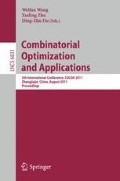Abstract
The Discretizable Molecular Distance Geometry Problem is a subset of instances of the distance geometry problem that can be solved by a combinatorial algorithm called “Branch-and-Prune”. It was observed empirically that the number of solutions of YES instances is always a power of two. We perform an extensive theoretical analysis of the number of solutions for these instances and we prove that this number is a power of two with probability one.
Access this chapter
Tax calculation will be finalised at checkout
Purchases are for personal use only
Preview
Unable to display preview. Download preview PDF.
References
Lavor, C., Liberti, L., Maculan, N.: Computational experience with the molecular distance geometry problem. In: Pintér, J. (ed.) Global Optimization: Scientific and Engineering Case Studies, pp. 213–225. Springer, Berlin (2006)
Liberti, L., Lavor, C., Maculan, N., Marinelli, F.: Double variable neighbourhood search with smoothing for the molecular distance geometry problem. Journal of Global Optimization 43, 207–218 (2009)
Saxe, J.: Embeddability of weighted graphs in k-space is strongly NP-hard. In: Proceedings of 17th Allerton Conference in Communications, Control and Computing, pp. 480–489 (1979)
Huang, H.X., Liang, Z.A., Pardalos, P.: Some properties for the Euclidean distance matrix and positive semidefinite matrix completion problems. Journal of Global Optimization 25, 3–21 (2003)
Hendrickson, B.: The molecule problem: exploiting structure in global optimization. SIAM Journal on Optimization 5, 835–857 (1995)
Eren, T., Goldenberg, D., Whiteley, W., Yang, Y., Morse, A., Anderson, B., Belhumeur, P.: Rigidity, computation, and randomization in network localization. IEEE Infocom Proceedings, 2673–2684 (2004)
Krislock, N., Wolkowicz, H.: Explicit sensor network localization using semidefinite representations and facial reductions. SIAM Journal on Optimization 20, 2679–2708 (2010)
Gunther, H.: NMR Spectroscopy: Basic Principles, Concepts, and Applications in Chemistry. Wiley, New York (1995)
Schlick, T.: Molecular modelling and simulation: an interdisciplinary guide. Springer, New York (2002)
Santana, R., Larrañaga, P., Lozano, J.: Combining variable neighbourhood search and estimation of distribution algorithms in the protein side chain placement problem. Journal of Heuristics 14, 519–547 (2008)
Lavor, C., Mucherino, A., Liberti, L., Maculan, N.: Discrete approaches for solving molecular distance geometry problems using NMR data. International Journal of Computational Biosciences 1(1), 88–94 (2010)
Lavor, C., Liberti, L., Maculan, N., Mucherino, A.: The discretizable molecular distance geometry problem. Computational Optimization and Applications doi: 10.1007/s10589-011-9402-6
Liberti, L., Lavor, C., Maculan, N.: A branch-and-prune algorithm for the molecular distance geometry problem. International Transactions in Operational Research 15, 1–17 (2008)
Mucherino, A., Lavor, C., Liberti, L.: The discretizable distance geometry problem. To appear in Optimization Letters
Lavor, C., Lee, J., John, A.L.S., Liberti, L., Mucherino, A., Sviridenko, M.: Discretization orders for distance geometry problems. Optimization Letters doi: 10.1007/s11590-011-0302-6
Lavor, C., Mucherino, A., Liberti, L., Maculan, N.: On the computation of protein backbones by using artificial backbones of hydrogens. Journal of Global Optimization 50, 329–344 (2011)
Liberti, L., Lavor, C., Mucherino, A., Maculan, N.: Molecular distance geometry methods: from continuous to discrete. International Transactions in Operational Research 18, 33–51 (2010)
Lavor, C., Liberti, L., Maculan, N., Mucherino, A.: Recent advances on the discretizable molecular distance geometry problem. European Journal of Operational Research (accepted / invited survey)
Blumenthal, L.: Theory and Applications of Distance Geometry. Oxford University Press, Oxford (1953)
Connelly, R.: Generic global rigidity. Discrete Computational Geometry 33, 549–563 (2005)
Brady, T., Watt, C.: On products of Euclidean reflections. American Mathematical Monthly 113, 826–829 (2006)
Lavor, C., Liberti, L., Maculan, N.: The discretizable molecular distance geometry problem. Technical Report q-bio/0608012, arXiv (2006)
Dong, Q., Wu, Z.: A geometric build-up algorithm for solving the molecular distance geometry problem with sparse distance data. Journal of Global Optimization 26, 321–333 (2003)
Coope, I.: Reliable computation of the points of intersection of n spheres in ℝn. Australian and New Zealand Industrial and Applied Mathematics Journal 42, C461–C477 (2000)
Author information
Authors and Affiliations
Editor information
Editors and Affiliations
Rights and permissions
Copyright information
© 2011 Springer-Verlag Berlin Heidelberg
About this paper
Cite this paper
Liberti, L., Masson, B., Lee, J., Lavor, C., Mucherino, A. (2011). On the Number of Solutions of the Discretizable Molecular Distance Geometry Problem. In: Wang, W., Zhu, X., Du, DZ. (eds) Combinatorial Optimization and Applications. COCOA 2011. Lecture Notes in Computer Science, vol 6831. Springer, Berlin, Heidelberg. https://doi.org/10.1007/978-3-642-22616-8_26
Download citation
DOI: https://doi.org/10.1007/978-3-642-22616-8_26
Publisher Name: Springer, Berlin, Heidelberg
Print ISBN: 978-3-642-22615-1
Online ISBN: 978-3-642-22616-8
eBook Packages: Computer ScienceComputer Science (R0)

